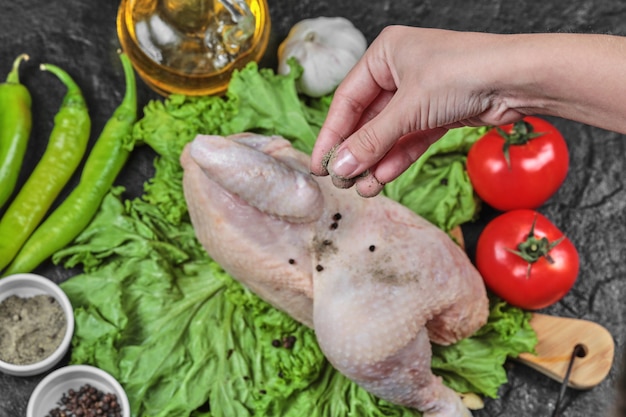chicken livers. The mere mention of them can send shivers down some spines, conjuring up images of oddly textured, intensely flavoured bites. But let me tell you, this humble organ meat has so much more to offer than meets the eye, or should I say, the palate. When treated with respect and cooked to perfection, chicken livers transform into a culinary treasure. They're rich, earthy, and surprisingly versatile, a budget-friendly protein powerhouse packed with nutrients. Now, the question that often pops up is: how many grams should I be eating? That's what we're going to dive into today, exploring the world of chicken livers with a mix of practical advice, personal anecdotes, and a dash of culinary adventure.
(Part 1) Chicken Livers: A Culinary Treasure

For years, chicken livers have held a special place in my culinary heart. It all started with a childhood memory of my grandmother's p??té, a creamy, rich spread served with crusty bread that was the epitome of comfort food. From that moment, I was hooked. I've since discovered their versatility, experimenting with everything from classic French p??té to bold Asian stir-fries. Chicken livers are like a blank canvas, waiting to be painted with your culinary imagination.
The nutritional powerhouse
Beyond their flavour, chicken livers are a true nutritional powerhouse. They're a fantastic source of iron, essential for producing those vital red blood cells that carry oxygen throughout our bodies. Imagine that, a single serving of chicken liver can give your energy levels a boost! They're also brimming with vitamins A and B12, crucial for healthy vision, nerve function, and cell growth. So, it's not just about the delicious taste; it's about nourishing your body with vital nutrients.
The Art of Choosing the Right Liver
Before we delve into the serving size debate, let's talk about picking the best livers for your culinary journey. You want livers that are firm, smooth, and a deep, rich red colour. They should be free from any blemishes or an unusual, pungent smell. Think of it like choosing fresh, high-quality ingredients for any other dish – the quality matters! The best chicken livers are usually found at your local butcher shop, where you can chat with the butcher and learn a few insider tips. If you're shopping at a supermarket, make sure the packaging is sealed properly and the livers are kept chilled. It's always a good idea to check the expiry date too.
(Part 2) Determining Your Serving Size

Now, let's tackle the big question: how many grams of chicken liver is enough? This is where things can get a bit tricky, as there's no one-size-fits-all answer. It depends on your individual needs, appetite, and the type of dish you're making.
Factors to Consider
Think of it as a culinary puzzle, and here are the pieces you need to fit together:
- Your Appetite: Are you a bottomless pit of a stomach or a light eater? Be honest with yourself about your appetite and adjust the serving size accordingly. No one wants to feel overstuffed or deprived!
- The Recipe: Some recipes call for a larger amount of liver, especially if they are the star of the show, like in a classic p??té. Others use them as a supporting element in a dish, like a stir-fry or a pasta sauce. The recipe itself will guide you.
- Your Dietary Needs: If you're watching your calorie intake, a smaller serving might be more suitable. If you're following a high-protein diet, you might opt for a larger serving. It's all about listening to your body and making choices that fit your lifestyle.
(Part 3) Understanding the Grams

Let's get down to brass tacks. Generally, a standard serving of chicken livers is between 70 and 100 grams. This range allows for flexibility based on the factors we just discussed.
Visualizing a Serving
Imagine a deck of cards. That's roughly the size of a standard 70-100 gram serving of chicken livers. You can use this visual guide as a starting point, but feel free to adjust it based on your preferences. Remember, it's all about finding what feels right for you.
(Part 4) cooking techniques and Serving Ideas
Now that you've got a grasp on the serving size, let's get cooking! Chicken livers are surprisingly versatile and can be cooked in many delicious ways.
Pan-Seared Delight
Pan-searing is one of my personal favorites. It creates a beautiful crispy exterior while keeping the interior tender and juicy. Season them simply with salt and pepper or get creative with herbs like thyme, rosemary, or sage. For a bolder flavour, try adding a pinch of smoked paprika or cayenne pepper. Serve them with a side of mashed potatoes, roasted vegetables, or a simple green salad for a satisfying meal.
The Enchanting World of P??te
If you're feeling adventurous, why not try making your own p??té? It's a classic French dish that showcases the richness and flavour of chicken livers beautifully. You'll need to blend the livers with butter, cream, and seasonings, then chill them until firm. Serve it on toasted baguette slices with a drizzle of olive oil or a dollop of fig jam for an elegant appetizer. It's a real crowd-pleaser, trust me! You can find countless p??té recipes online and in cookbooks, and it's worth experimenting with different flavour combinations.
Stir-Frying for an Asian Twist
Chicken livers can also be a fantastic addition to stir-fries, adding a delicious depth of flavour and a rich texture. Slice the livers thinly and stir-fry them with your favourite vegetables, such as broccoli, carrots, and peppers. Finish with a sauce of soy sauce, ginger, and garlic for an Asian-inspired delight.
Other Culinary Adventures
Besides these classic techniques, there are many other ways to cook chicken livers. They can be added to pasta sauces, used in terrines, or even made into a delicious crostini topping. The possibilities are endless!
(Part 5) Tips for Cooking Success
Here are a few tips to ensure your chicken liver cooking experience is a success. Remember, confidence in the kitchen is key!
- Don't Overcook: Chicken livers cook very quickly. Overcooking will make them tough and dry. Aim for medium-rare, with a pink center. It's best to cook them on medium-high heat for just a few minutes per side. You can always test for doneness by cutting into a liver and checking for a pink interior.
- Soak in Milk: Soaking the livers in milk for about 30 minutes before cooking helps to remove any bitterness and makes them more tender. The milk will also add a subtle creaminess to the flavour.
- Season Liberally: Chicken livers have a distinct flavour, so don't be shy with the seasonings. Salt, pepper, herbs, and spices all work wonderfully. Experiment with different flavour profiles to find your favorites.
- Rest Before Serving: After cooking, let the livers rest for a few minutes before slicing and serving. This allows the juices to redistribute and ensures a more tender texture. It's a simple step that makes a big difference in the overall flavour and texture.
(Part 6) A Culinary Adventure Awaits
Cooking with chicken livers is a fantastic way to explore new flavours and textures. Don't be afraid to experiment with different recipes and techniques. You might just surprise yourself with the delicious results! It's all about having fun and being open to culinary adventures.
(Part 7) Chicken Livers: Beyond the Plate
While chicken livers are a fantastic addition to any meal, their benefits go beyond the plate. They're a great source of iron, particularly important for pregnant women and those with iron deficiency. They're also a good source of protein and vitamins, making them a great option for anyone looking for a healthy and satisfying meal.
Iron Richness and Pregnancy
During pregnancy, iron levels are crucial for both the mother and the developing baby. Chicken livers, with their high iron content, can be a beneficial part of a balanced diet, helping to combat iron deficiency and prevent complications like fatigue and anemia.
A Healthy Choice for Everyone
Beyond pregnancy, chicken livers are a nutrient-rich source of protein and vitamins for anyone looking for a healthy and satisfying meal. They can be incorporated into various dishes, from traditional p??tés to modern stir-fries, making them a versatile and delicious option for a balanced diet.
(Part 8) A Word of Caution
While chicken livers are delicious and nutritious, it's important to note that they are high in cholesterol. If you're concerned about cholesterol levels, you might want to limit your intake. As with any food, moderation is key!
Cholesterol and Dietary Considerations
For individuals with high cholesterol levels or those who are following a low-cholesterol diet, it's essential to be mindful of their intake of chicken livers. However, incorporating them into a balanced diet and limiting servings can still allow for enjoyment of their unique flavour and nutritional benefits.
(Part 9) FAQs
Here are some frequently asked questions about chicken livers, to address those lingering doubts and curiosities.
Q: How do I know if chicken livers are fresh?
Fresh chicken livers are firm, smooth, and a deep, rich red colour. Avoid those that are pale, dry, or have a strong ammonia smell. It's also a good idea to check the expiry date. Trust your senses!
Q: Can I freeze chicken livers?
Yes, you can freeze chicken livers. Wrap them tightly in plastic wrap or place them in a freezer-safe bag. They can be frozen for up to 3 months. Defrost them in the refrigerator overnight before using.
Q: How do I remove the bitterness from chicken livers?
Soaking the livers in milk for about 30 minutes before cooking helps to remove any bitterness and makes them more tender. The milk will also add a subtle creaminess to the flavour.
Q: What are some good side dishes for chicken livers?
Some classic side dishes for chicken livers include mashed potatoes, roasted vegetables, and crusty bread. But feel free to get creative! You can also pair them with a simple green salad, a creamy risotto, or even a light pasta dish.
Q: Are chicken livers good for you?
Chicken livers are a good source of iron, vitamins A and B12, and protein. They are also relatively low in calories and fat. However, they are high in cholesterol, so it's important to eat them in moderation. Ultimately, the answer is: it depends! They can be a part of a balanced diet, but it's crucial to consider your individual dietary needs and preferences.
(Part 10) The Final Bite
So, there you have it! I hope this guide has shed some light on the wonderful world of chicken livers. Remember, don't be afraid to experiment, and most importantly, enjoy the delicious results! Bon appétit!
Everyone is watching

Corn on the Cob: The Ultimate Guide to Perfectly Cooked Ears
Healthy MealsAh, corn on the cob. Just the name evokes images of sunny days, barbecues, and that sweet, juicy flavour that ...

Perfect Pork Roast Oven Cooking Time: A Guide to Delicious Results
Healthy MealsThere's something truly satisfying about a perfectly roasted pork. The aroma alone is enough to make your mout...

Ham Cooking Time: How Long to Bake, Smoke, or Boil a Delicious Ham
Healthy MealsAh, ham. It's a classic, isn't it? A real crowd-pleaser, especially around holidays. And when done right, it'...

Scallops: The Ultimate Guide to Perfect Cooking
Healthy MealsAh, scallops. Those delicate, sweet, and utterly delicious morsels of the sea. They hold a special place in my...

Spaghetti Squash: The Ultimate Guide to Cooking and Serving
Healthy MealsRemember that time you saw spaghetti squash at the supermarket, looking all bumpy and strange, and thought, "W...
